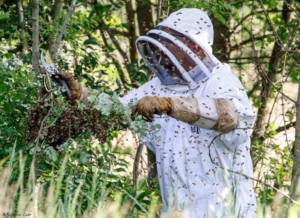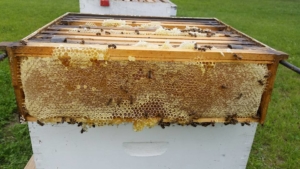What’s that buzz? It’s Schmidt Associates’ New Bee Hive on our Green Roof!
-
Category
Studio-Workplace, Studio-Lifestyle, Studio-Community -
Posted By
Schmidt Associates -
Posted On
May 20, 2019
In case you haven’t heard the buzz, Schmidt Associates is now an urban beekeeper with a honeybee hive on our roof.
Luckily, Mark Manship, one of our construction administrators, maintains two beehives at home and has become the keeper of our hives. Since many of us are curious about what this means, we decided to sit down and ask him about being a beekeeper. Check back for future blogs with more information and check out our social media sites. We’ll regularly have pictures posted with captions about the bees’ progress.




How did you get into this?
About five years ago my wife and I moved to a property with 3.5 acres of land. My wife wanted to get chickens, and I said “no” (I had them as a child and didn’t want them again.) She mentioned bees, and I said sure. We got a nucleus hive (or nuke), a starter hive with 5 full frames of bees. Unfortunately, they didn’t last the winter, and we started over with a couple of new varieties of honey bees. We had some success, and they were thriving. Someone my wife knew wanted to retire and needed to find someone to take his bees. We reached out to some friends who were also interested in beekeeping, and together we purchased all his hives and equipment. After splitting this among our friends, we were at our peak capacity of 12 hives of various breeds of honeybees from all over the world on our property.
Though it began as my wife’s hobby, I helped a lot. With a background in carpentry, I made the hive stands and helped with transportation. Not long after we started, I had a swarm of honeybees land on a tree by my old office, and we wanted to capture the swarm to move them. We contact the Indiana Department of Natural Resources (IDNR) about regulations to capture swarms. We were encouraged to contact a beekeeper or capture them ourselves. That’s when I got hooked. Saving the bees.
We are now listed on the IDNR swarm list for East Central Indiana. When someone finds a swarm of bees, they typically call pest control. Pest control refers them to the IDNR swarm list to have someone come catch them.

Mark Manship moving a bee swarm
I bought three new packages of bees this spring, one for our homestead, one for an offsite location, and one for the green roof at Schmidt Associates.


Schmidt Associates’ Green Roof with a New Bee Hive!What goes into maintaining a hive?
Once the hive is established, about once a week you open the hive to look for brood cells to make sure they are multiplying. You also look for honey stores and check the general health of the bees. You check for signs of pest intrusion and adjust accordingly. Another part is looking for additional queen cells, or an abundance of bees which may indicate they are ready to split or swarm and create another hive.
You need to make sure they are healthy, but if they get overly healthy, the hive needs expansion or needs to be split. I’m still learning and taking over the hive keeping at home. We’ve been doing this for about four years, but it was mainly my wife. Now the apprentice is the beekeeper. And I get to do it at the office too, which is great!




Check back in a few weeks for more information about honey production and the benefits of bees!






